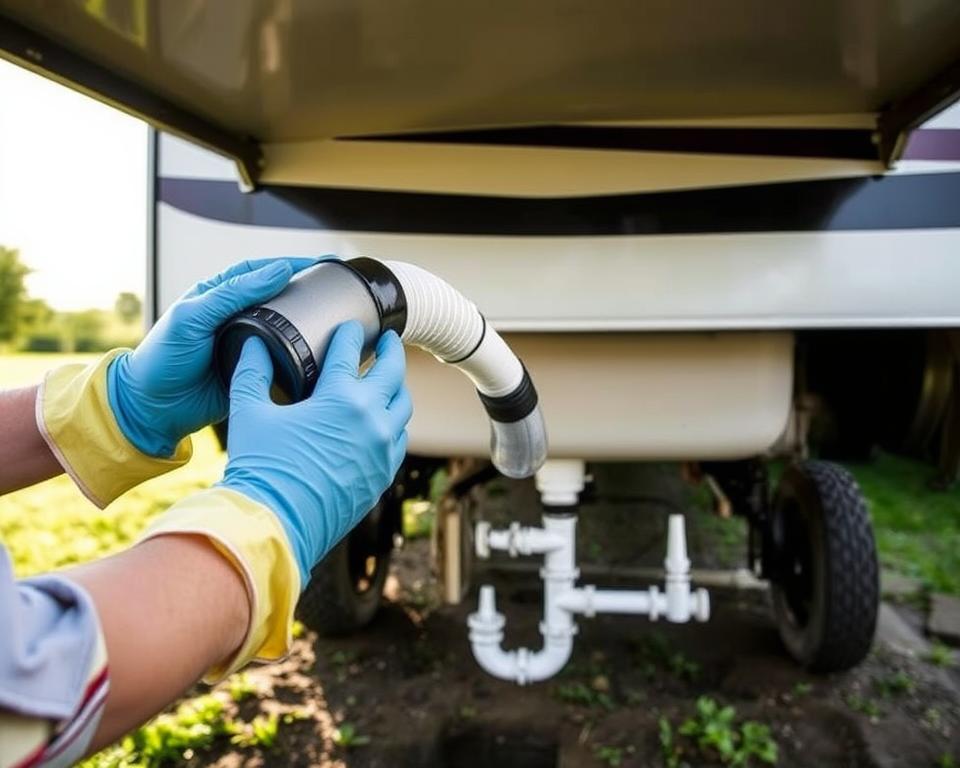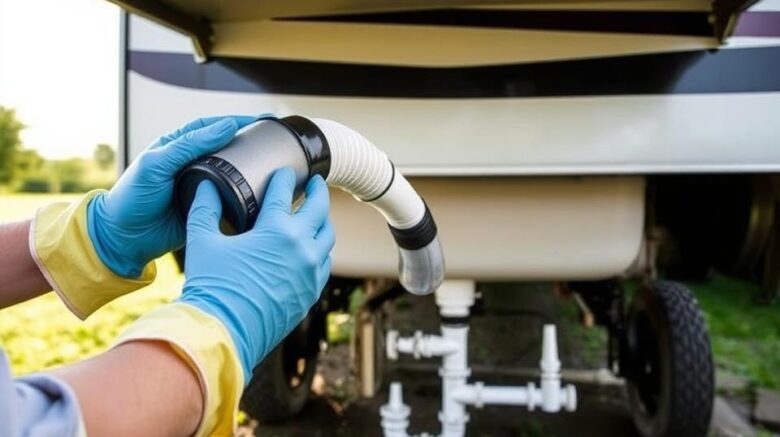Motorhome Water Tank & Pump: – Essential Resource
Intrigued by the key to easy roaming?? It’s chiefly due to your RV water Tank and Pump. If you’re bound for iconic parks or just a weekend retreat, commanding your RV’s water system is crucial. The following guide we unpack the fundamentals: the elements, maintenance, and strategies for glitch-free travel. Knowing each element, from the pipework to reservoir filling, secures water is always ready during your excursions – RV septic pumping near me.
Vital Observations
- Mastering the RV fresh-water setup elevates your travel experience.
- The RV water Tank and Pump are central for a steady water supply.
- Consistent upkeep protects the longevity of your RV plumbing.
- Knowing proper fill techniques for your reservoir properly can avert future issues.
- Diagnosing your water Pump can spare you sudden problems.
Demystifying RV Water Systems
RV water systems divide into two principal parts: the potable-water setup and the used-water mechanism. The fresh side houses several critical pieces like the water Tank, pressure Pump, and faucets, mirroring domestic plumbing yet tailored for the dynamic needs of living on the move.
Supplying potable water is paramount for the system’s efficiency. It protects the well-being of all passengers. It’s important to keep the RV plumbing in prime condition through routine maintenance – including proper drainage to prevent leaks and other faults. Frequent inspections enable RV enthusiasts dodge water-related surprises during their journeys.

Why You Need the RV Water Tank
The RV fresh-water reservoir is central for a smooth journey. It stores the clean water required for drinking, cooking, and cleaning. The volume of this Tank changes with each RV model, affecting how much water can be stored – and this directly influences how long you can stay off-grid before needing a refill.
Keeping the RV water Tank clean is critical. Regular cleaning keeps at bay dangerous contaminants, ensuring water remains safe for use. Ignoring maintenance can encourage bacteria or algae growth, rendering the water hazardous.
Understanding the RV Tank’s role streamlines water management during trips. Diligent upkeep and frequent refills provide a worry-free experience. It’s key to have ample water for all travel needs, ensuring a trouble-free RV adventure.
Filling Your RV Fresh-Water Tank
Refilling your RV water Tank requires attentive action to ensure it’s done correctly. There are two primary methods: gravity filling and city-pressure filling. Understanding these techniques greatly improves your RV experience.
Gravity filling is simple. You just need a drink-safe water hose. Connect this hose to a water source, then to the fill opening, and allow gravity take over. Remember to monitor the water level to avoid spills.
Pressure filling relies on a city water connection, which is faster delivery. You need to use a pressure regulator to control water flow. Connect the hose from the municipal source to your RV. This method provides quick and consistent supply to your Tank.
Choosing approach you prefer, follow these important safety tips: Consistently monitor the Tank when filling to prevent overflow, and use clean water to ward off health issues. Knowing these filling and safety techniques will turn your RV trips even more enjoyable.
RV Water Tank and Pump: Parts in Focus
The RV Tank-and-Pump combo are critical to any RV’s plumbing system, providing a steady and smooth water supply for all your needs. The RV water Pump’s main job is to push water from the Tank, ensuring clean water is always ready. That’s critical for cooking, cleaning, and showering.
RV plumbing offers different Pump types, each with individual benefits. Diaphragm-style Pumps are favoured for their consistent water pressure, while centrifugal models are loved for ease and energy thrift. It’s essential to weigh flow rate, noise, and installation ease when choosing your Pump.
To conclude, the RV water Tank and Pump are non-negotiable to your water system’s functioning. A dependable Pump secures strong pressure and smooth flow, improving your overall travel experience.
Selecting the Best-Fit RV Water Pump
Finding the ideal RV water Pump is vital for your water system’s optimal performance. When picking a Pump, considering a few points is critical for a positive camping experience. Ensuring it pairs with your RV’s water system is key.
Keep these primary aspects in mind:
- Flow Rate: Opt for a Pump with a flow rate that suits your usage requirements. A higher flow means faster reservoir refills.
- Pressure Ratings: Your RV’s multiple fixtures determine the needed pressure levels. Go with a Pump whose specs satisfy those figures for smooth operation.
- Noise Levels: Noise can be an issue with some Pumps. For peace and quiet, compare models for their noise output.
Brands like SHURflo and VEVOR are favourites for many RVers, each offering unique features. A careful assessment of these brands will assist your decision-making process.
Grasping these factors is not only crucial for the proper purchase but also equips DIY owners with key know-how for upkeep and replacements.
Using City Water for Your RV
Hooking your RV to city water allows for an continuous supply of fresh water, moving you beyond just using your Tank. This ensures a more comfortable camping experience. Make sure to follow safe steps for a secure hookup.
First, identify the city water connection port on your RV. It’s often marked by a white or black connector, sometimes tagged for ease. Grab a potable water hose rated for RVs; this type of hose protects your water safe from contaminants.
It’s critical to attach a pressure regulator before making the connection. This fitting shields your plumbing by controlling the water pressure. With the regulator in place, link the hose from it to the water source.
Once connected, watch the water pressure. Maintain a steady, gentle flow to prevent hose damage. Inspect your hoses regularly for any wear or leaks and quickly replace parts as needed.
Following these steps for city hookup boosts your camping convenience and assists in maintaining your RV’s condition.
Maintaining Your RV Fresh-Water Tank
Keeping your RV’s water Tank is well cared for is vital for safe, clean water while travelling. A sound Tank helps prevent bacterial growth and contamination. To begin, regularly sanitise the Tank: mix water with a bit of bleach for an efficient residue-free clean.
It’s important to check leaks and control Tank pressure. Regular checks can detect problems early, avoiding expensive fixes. A solid schedule keeps the water system in prime condition.
For optimal maintenance, create a checklist:
- Check water levels and quality often.
- Sanitise the Tank every six months with a bleach solution.
- Inspect for cracks in the reservoir.
- Monitor Tank pressure and Pump function.
- Flush the Tank to eliminate any sediment buildup.
RV Water Pump Diagnostics
RV water Pump glitches can be annoying, disrupting travel plans without warning. Encountering strange noises, experiencing low pressure, or suffering complete Pump failure are common problems. Understanding how to troubleshoot these issues can significantly improve your trips.
If you hear odd sounds from your Pump may signal a problem. Start : check for loose connections and secure them. When you face low water pressure, checking hoses and fittings for leaks. Even a small leak can dramatically affect flow, prompt troubleshooting is essential.
If your Pump fails altogether, verify electrical connections. Start with examining the Pump’s fuse. Should the fuse is fine, continue diagnosing for wear or damage.
A step-by-step routine isolates and resolves water system issues. Regular maintenance and inspection ensure hassle-free journeys.
| Issue | Possible Cause | Suggested Solution |
|---|---|---|
| Strange Noises | Loose connections | Tighten fittings |
| Low Pressure | Leaky hoses/fittings | Find & seal leaks |
| Pump Failure | Electrical fault | Check fuse/wiring |
| No Water Flow | Blocked lines | Flush obstructions |
Tips for Efficient RV Water Use
Boondocking in isolated areas typically entails limited water access. Efficient use in your RV is key. By embracing smart conservation tactics, you not only manage resources well but also heighten camping satisfaction.
To make the most of water while travelling, use these tips:
- Take brief showers – aim for under five minutes.
- Install water-saving fixtures like low-flow showerheads and faucets.
- Reuse used water: dishwater can flush toilets or water plants.
- Monitor reservoir levels regularly to avoid overflow.
- Plan water stops in advance: know filling stations along your route.
The Bottom Line
Grasping the nuts and bolts of your RV water systems is crucial to a successful travel adventure. The water Tank & Pump remain at the centre of this, requiring routine upkeep. By maintaining these systems, you secure a dependable supply and dodge potential snags.
Diligent troubleshooting and checks reduce stress and save time. Being proactive about upkeep is essential, particularly when you’re far from help. Proper care allows you to maximise water use, boosting comfort for everyone.
On your next outing, keep this guide to master your RV’s water systems. Smart decisions about plumbing and equipment prepare you to embrace the freedom of the road. Enjoy joyous and smooth travels ahead!
